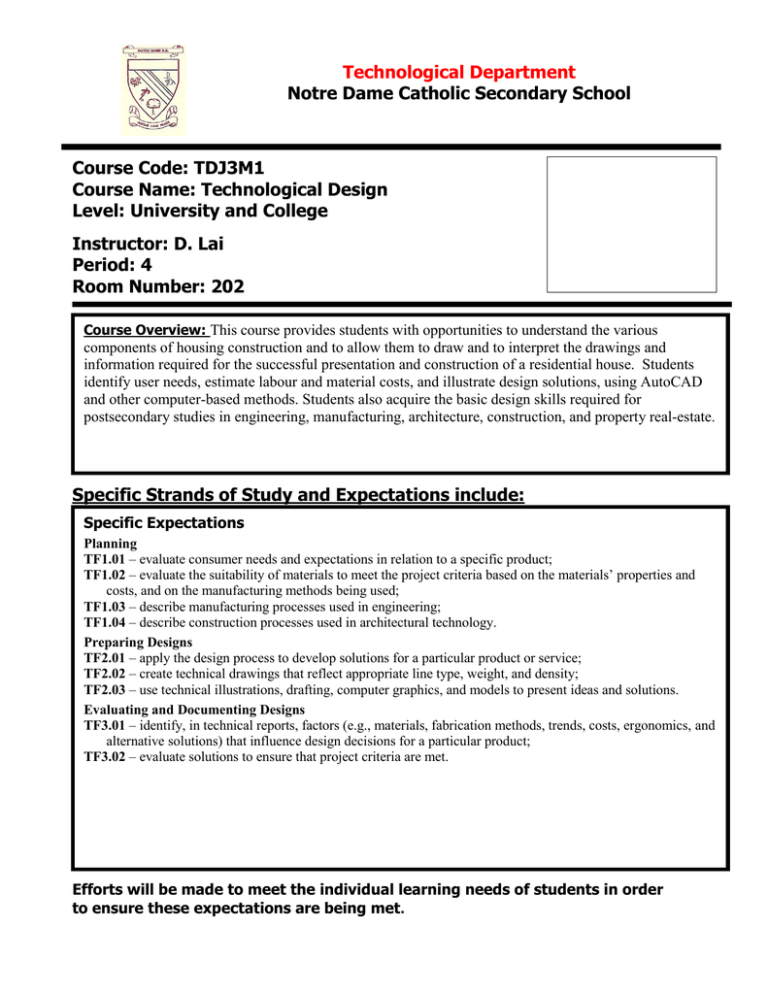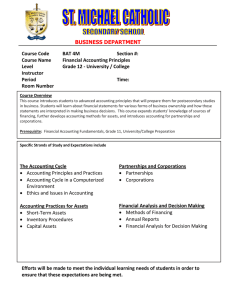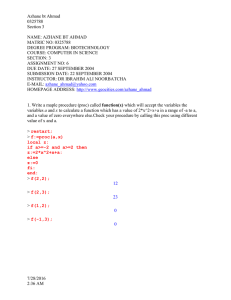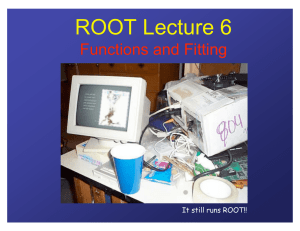Notre Dame Catholic Secondary School Course Code: TDJ3M1 Course Name: Technological Design
advertisement

Technological Department Notre Dame Catholic Secondary School Course Code: TDJ3M1 Course Name: Technological Design Level: University and College Instructor: D. Lai Period: 4 Room Number: 202 Course Overview: This course provides students with opportunities to understand the various components of housing construction and to allow them to draw and to interpret the drawings and information required for the successful presentation and construction of a residential house. Students identify user needs, estimate labour and material costs, and illustrate design solutions, using AutoCAD and other computer-based methods. Students also acquire the basic design skills required for postsecondary studies in engineering, manufacturing, architecture, construction, and property real-estate. Specific Strands of Study and Expectations include: Specific Expectations Planning TF1.01 – evaluate consumer needs and expectations in relation to a specific product; TF1.02 – evaluate the suitability of materials to meet the project criteria based on the materials’ properties and costs, and on the manufacturing methods being used; TF1.03 – describe manufacturing processes used in engineering; TF1.04 – describe construction processes used in architectural technology. Preparing Designs TF2.01 – apply the design process to develop solutions for a particular product or service; TF2.02 – create technical drawings that reflect appropriate line type, weight, and density; TF2.03 – use technical illustrations, drafting, computer graphics, and models to present ideas and solutions. Evaluating and Documenting Designs TF3.01 – identify, in technical reports, factors (e.g., materials, fabrication methods, trends, costs, ergonomics, and alternative solutions) that influence design decisions for a particular product; TF3.02 – evaluate solutions to ensure that project criteria are met. Efforts will be made to meet the individual learning needs of students in order to ensure these expectations are being met. Course Breakdown Unit 1: Technological Design Fundamentals: Understanding residential houses Unit 2: Technological Design Skills: AutoCAD LT2002 Commands & Features Unit 3: Technology, the Environment and Society Unit 4: Professional Practice and Career Opportunities: Application Design: Students learn the basic skills in drafting isometric drawing. After the isometric activity, each student designs at least 7 or more of the following open-end applications using AutoCAD: 1) Kitchen 7) Dining & Living Room 2) Floor Details 8) Basement 3) Wall Frame 4) Foundation 5) Roof details 6) Bungalow Floor Plan Resources: The course will use a variety of resources including video, CD-ROM, Internet Applications and a variety of print sources. The textbook Architecture Drafting and Design and/or Architectural Drawing and Design, for residential Construction will be distributed to students during the first week of the course. The text and all other resources assigned to students are the responsibility of the student. Any damage incurred will result in payment for replacement. Replacement cost for the text is $100.00. Evaluation Structure:: Knowledge/Understanding Thinking/Inquiry Communication Application 25% 20% 25% 30% The above is reflected both in the term work (worth 70% of the final mark) and the summative work (worth 30% of the final mark). Summative work consists of the Final Exam (20%) and a Culminating Performance Task (10%). Evaluation Policy Students will be assessed & evaluated according to the work produced & skills displayed. Methods of providing feedback will include assessing work in process & evaluating completed assignments, tests, simulations and presentations. Student marks will be determined by evaluating process & product according to 4 categories & 4 levels. Please see the chart below for specific skills and key words used to determine student competency in the different categories. Level Category Knowledge/Understanding Knowledge of facts & terms Understanding of concepts & relationships Thinking/Inquiry Critical thinking skills Creative thinking skills Inquiry Skills Communication Communication of ideas and information Use of symbols & visuals Oral & written communication Level 1: 50-59% Level 2: 60-69% Level 3: 70-79% Level 4: 80-100% -Limited display of knowledge, skills and ability to apply concepts -Some success in displaying knowledge, skills and application of concepts -Considerable display of knowledge skills and ability to apply concepts -Thorough understanding of concepts and ability to communicate, think creatively and apply concepts Application Applications in familiar contexts Transfer of concepts to new contexts Making logical conclusions and predictions Use of technology Making connections Feedback will also be provided for student learning skills. Skills like working independently, team work, organization, work habits and homework, and initiative are assessed independently student achievement and will be conducted through the use of a rubric indicating specific criteria to be achieved to receive each of the following letter grades: E –Excellent Other Evaluation Issues G – Good S – Satisfactory N - Needs Improvement LATE ASSIGNMENTS. Assignments submitted after the Primary Due Date established by the teacher will be accepted with a penalty of 5% off for the first day late and 3% for subsequent days to a maximum of 10%. This three-day Penalty Zone is the maximum time allowed for submissions. The third day after the assignment is due is considered the Closure Date upon which no further assignments will be accepted. If the teacher returns the marked assignments within the three day penalty zone, the date of return is considered the closure date. Repeated lateness in submissions indicates poor organization skills and will result in parental contact and will be reflected in the learning skills section of the report card. INCOMPLETE ASSSIGNMENTS Assignments will be graded according to the extent with which they meet the criteria established in the rubric or evaluation structure. MISSED TESTS Tests missed with a legitimate reason will be written within two days of the student returning from the absence. Student eligibility to write the test and the date of writing will be at the discretion of the teacher in consultation with the department head. CULMINATING ACTIVITIES These activities will be due toward the end of the course. They are valued 10 per cent of the final mark and will reflect course material and competencies not otherwise reflected on the final exam. Plagiarism in any form reflects academic dishonesty and will result in a mark of zero for the assignment in question





